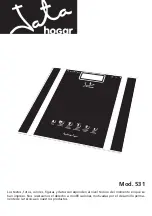
PSE
.
37
.
format (¡ nn¡ is a decimal number of page, ¡ xxxx¡ is an hexadecimal value of parameter, e.g.
02
:
85E2
).
01-02 pages: zero code;
03-04 pages: standard weight of
CAL.P1
;
05-06 pages: codes of
CAL.P1
;
07-08 pages: standard weight of
CAL.P2
;
09-10 pages: codes of
CAL.P2
;
11-12 pages: full capacity net code;
13-14 pages: the coefficient of weight fine-tune;
15-16 pages: gravity value of calibration location;
17-18 pages: gravity value of the location that the scale is used at.
b.
When there is no digit flashing on the LCD, this means the calibration parameters value are
being viewed, and use the
UNIT/DATA
key to view the next page, use the
SETUP
key to return
to last sub-menu, or use the
ZERO/ON/OFF
key to exit.
c.
When parameters value are being viewed, use the
UNIT/DATA
key to prepare to modify. When
the first digit is flashing, this means the value is being modified. Use the
UNIT/DATA
key to
make the next digit flash (if current flashing position is the last one, next page value will be
shown), use key to input number, and use the
TARE/PRESET
key to confirm.
d.
In this mode, press and hold the
PRINT/FUNC
key more than 4 seconds, for these parameters
to be sent out. The print out format is <LF>nn:xxxx<CR>; there are a total of eighteen lines.
8.
After the indicator receives all the necessary data, it will calculate and store all calibration
parameters into EEPROM, and after finishing the calibration it will display
CAL.End
. Then, it will
re-start and return to original mode.










































